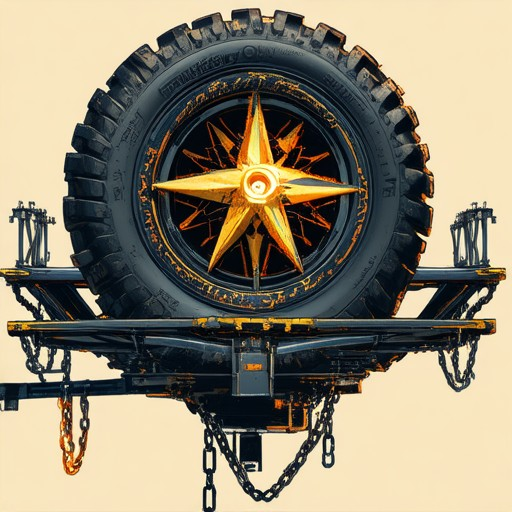Are your mud tires showing signs of wear or underperforming? Proper mud tire maintenance is crucial for extending their life and ensuring peak performance. Whether you’re navigating tough trails or dealing with everyday commutes, keeping your mud tires in top shape can make a significant difference in longevity and reliability. This comprehensive guide will walk you through essential maintenance practices, including cleaning techniques, balancing tips, rotation schedules, and when it’s time for replacement. By following these guidelines, you can keep your mud tires running smoothly and efficiently, enhancing both their durability and your driving experience.
To effectively extend the life and performance of your mud tires, follow these organized steps:
- Regular Inspections:
- Periodically check for signs of wear such as cracked tread, low tread depth, sidewall damage, and uneven wear. Inspect the valve stems for damage as well.
- Use a penny to check tread depth, ensuring it’s at least 1/16th of an inch.
- Rotation Schedule:
- Adhere to manufacturer guidelines, typically every 3,000 to 5,000 miles for mud tires, considering their harsher usage.
- For occasional off-road use, extend the interval but still check tread depth regularly.
- Usage Considerations:
- Reserve mud tires for off-road or challenging conditions. Use all-terrain tires for daily commuting to enjoy better fuel efficiency and comfort.
- Puncture Handling:
- Detect internal punctures early, as they can be difficult to spot. Replace tires if you suspect internal damage.
- Cost and Safety:
- Invest in regular maintenance to avoid costly replacements and ensure safe driving conditions.
- Consult Manufacturer Guidelines:
- Review your vehicle’s owner manual for specific recommendations tailored to your SUV.
By following these steps, you can maximize the lifespan and performance of your mud tires, ensuring they provide reliable service when needed most.

How to Make Mud Tires Last Longer
Mud tires are built to withstand tough off-road conditions, but their lifespan can still be impacted by several factors. By following proper maintenance practices, you can extend the life of your mud tires.
1. Regular Tire Pressure Checks
Proper inflation is crucial for tire longevity. Always check your tire pressure before heading off-road. Underinflated or overinflated tires can lead to uneven wear and quicker deterioration.
2. Rotate Tires Consistently
Rotating your tires periodically helps distribute wear patterns evenly across all four tires. Front and rear tires tend to wear differently due to varying weight distribution, so keep them switched up to maintain balance and even wear.
3. Maintain Proper Wheel Alignment
Uneven wear caused by misalignment can significantly shorten the lifespan of your tires. Schedule regular alignments to ensure your wheels are pointing in the right direction, promoting even wear and extending tire life.
4. Park Safely to Protect Tires
When possible, park in protected areas such as garages or covered parking lots to avoid curbs and potholes, which can cause impact damage and wear patterns.
5. Drive Carefully on Rough Terrain
Speeding through bumpy surfaces can shake your tires loose, causing irregular wear. Take it slow and steady to minimize stress on your mud tires.
6. Choose the Right Size and Type
Selecting the correct size and type of mud tire for your vehicle and terrain is essential. Larger tires may offer more protection, while smaller ones might be better suited for tighter turns. Consider your vehicle’s requirements and driving habits when making your choice.
7. Use Mud Flaps
Install mud flaps or rock guards to prevent debris and rocks from hitting your tires during off-road adventures. This can reduce the risk of punctures and minor damage.
8. Store Tires Properly
When not in use, store your mud tires in a cool, dry place away from direct sunlight and extreme temperatures. Exposure to UV rays can degrade rubber over time.
9. Avoid Quick Fixes
Never attempt to patch or fix small issues yourself. These temporary fixes often lead to more significant problems down the road, requiring costly replacements sooner rather than later. Always opt for professional repairs or replacements when necessary.
10. Replace Worn Tires Timely
Inspect your tires regularly for signs of wear, such as cracks, bulges, or thin spots. Replacing worn-out tires before they become unsafe is crucial for both performance and safety.
By following these tips, you can enjoy extended lifespan from your mud tires, making them a reliable investment for your off-road adventures.
For more detailed care tips and recommendations, visit our Tire Care Guide or explore our selection of mud tires designed for various off-road applications.
How Often Should I Balance Mud Tires?
Balancing your mud tires is crucial for maintaining optimal performance and safety. Here’s a breakdown of the recommended frequency:
- General Recommendation:** Every 5,000 to 7,000 miles – This interval applies to most vehicles under normal driving conditions.
- Heavier Vehicles:** Every 3,000 to 5,000 miles – Trucks, SUVs, and four-wheel-drive vehicles that carry significant weight may benefit from more frequent checks due to increased stress on tires.
- Off-Road Use:** Every 2,500 to 4,000 miles – If you frequently drive on rough terrain or engage in mud racing, consider balancing more often to prevent uneven wear and improve handling.
Additional Factors to Consider:
- Driving Habits:** Frequent highway driving may align with the standard interval, while towing or heavy loads may necessitate more frequent checks.
- Terrain Conditions:** Rough surfaces can increase the need for balancing, particularly for off-road use.
- Tire Size:** Larger tires used in mud racing or off-road contexts may require more attention due to their larger contact patch.
Remember, balancing ensures even wear and optimal performance, contributing to safer and more enjoyable driving experiences. Always consult a professional if unsure, as incorrect balancing can lead to costly repairs and reduced safety.

Why Does My Nissan Say Maintenance Tire?
Your Nissan is indicating that it’s time to replace or check the maintenance tires. This alert typically occurs during a routine maintenance check or when the vehicle’s computer detects that the current tires may not meet safety or performance standards. Here’s a breakdown:
- Monitoring System:** The vehicle’s onboard computer continuously monitors tire condition through sensors embedded in the wheels.
- Tire Type:** The system flags tires that may be worn, under-inflated, or damaged, prompting a reminder to replace them with properly sized and rated maintenance tires.
- Scheduled Maintenance:** Part of a regular maintenance schedule, ensuring tires are in optimal condition for safety and performance.
- Warning Indicators:** A dashboard light or message may appear, advising you to inspect or replace the tires to maintain proper handling and safety features.
- Professional Inspection:** Recommended to have a certified technician assess and replace if necessary, ensuring compliance with manufacturer specifications and safety regulations.
Addressing this alert promptly helps maintain your vehicle’s performance and safety on the road. Replace the tires with the correct size and quality recommended by your Nissan’s specifications to avoid further issues and ensure reliable driving conditions.

How to Know When Mud Tires Need Replacement
If you’re wondering whether your mud tires need replacement, here are some clear signs to watch out for:
- Cracked Tread: If you notice deep cracks or splits in the tread, it’s time to replace the tires. These cracks can lead to rapid deterioration and loss of traction.
- Low Tread Depth: Check the tread depth using a coin or a penny. If the tread is less than 1/16th of an inch deep, it’s worn out and needs replacement.
- Sidewall Damage: Look for any bulges, cuts, or damage along the sidewall. This type of damage can cause the tire to lose air quickly or even lead to a blowout.
- Worn-Out Tread: If the tread pattern is worn smooth or appears flat, it’s a clear indication that the tires are no longer providing adequate traction or control.
- Internal Puncture: If you find small holes inside the tire, it likely has an internal puncture that could cause the tire to collapse unexpectedly.
- Valve Stem Issues: If the valve stem is cracked, missing, or otherwise damaged, the tire won’t hold air properly, making it unsafe to drive.
- Uneven Wear: If one side of the tire is wearing faster than the other, it indicates potential alignment issues or excessive stress on the tire, which can lead to further damage.
- Aged Tires: Old tires simply wear out over time and lose their effectiveness, especially on rough terrain. Replace them when you notice they’re showing signs of age.
Don’t wait until it’s too late—replace your mud tires when you notice any of these warning signs to ensure safety and optimal performance on the trails.
Mud Tires Rotation Frequency
Your mud tires should be rotated according to a schedule that considers both manufacturer recommendations and usage patterns. Here’s a breakdown:
- Manufacturer Guidelines:** Typically recommend every 5,000 miles, but this may vary.
- Mud Tire Requirements:** Due to their off-road use and potential for increased wear, consider rotating every 3,000 to 5,000 miles, depending on usage intensity.
- Usage Factors:** Frequent or heavy off-road use may necessitate more frequent rotations, potentially down to every 2,500 miles.
- Regular Use:** Occasional or light off-road use may allow for every 10,000 miles, though checking tread depth is crucial.
- Balancing Wear:** Regular rotations help balance tread wear, extending overall tire life.
- Damage Check:** Rotate earlier if tires show uneven wear or damage, such as from punctures.
Always consult your vehicle’s owner manual for specific recommendations tailored to your model. Regular inspections and adherence to these guidelines will optimize your mud tires’ performance and longevity.

Are Mud Tires Bad for Daily Driving?
Mud tires are specifically designed for off-road conditions, offering exceptional traction on loose surfaces like dirt, mud, and gravel. However, their performance in daily driving scenarios can vary depending on several factors.
Pros of Mud Tires for Daily Driving
- Traction: Mud tires provide excellent grip on uneven surfaces, which can be beneficial during adverse weather conditions.
- Durability: They are built to withstand rough terrain, making them a reliable choice for heavy-duty applications.
Cons of Mud Tires for Daily Driving
- Wear Rate: Mud tires tend to wear faster compared to all-terrain tires due to their aggressive tread patterns.
- Fuel Efficiency: The deep treads can increase rolling resistance, leading to lower fuel economy.
- Noise Levels: They are generally noisier on paved roads, which can be annoying during long commutes.
- Performance in Wet Conditions: While they handle mud well, their performance on wet or snow-covered roads may not be as effective as all-terrain tires.
Comparison to All-Terrain Tires
- All-Terrain Tires vs. Mud Tires: All-terrain tires are more versatile for daily driving and light off-road use, offering better performance on paved roads and in snow or mud without the excessive wear and noise of mud tires.
When to Choose Mud Tires for Daily Driving
- If you frequently encounter unpaved roads or off-road trails, mud tires can be a practical choice.
- For vehicles used in competitive off-road racing or extreme conditions, mud tires provide the necessary traction and durability.
Conclusion
While mud tires excel in off-road situations, they may not be the best option for daily driving due to higher wear rates, reduced fuel efficiency, and increased noise levels. For typical daily commutes or light off-road use, all-terrain tires often provide a better balance of performance and convenience.
Learn more about tire options and find the perfect fit for your vehicle .




0 Comments